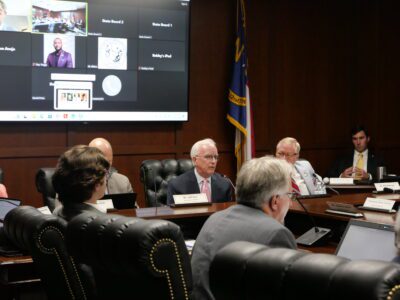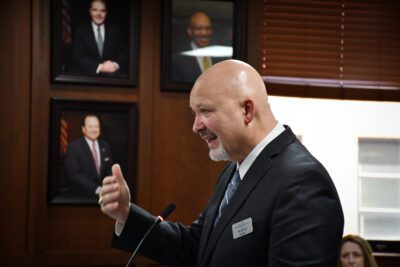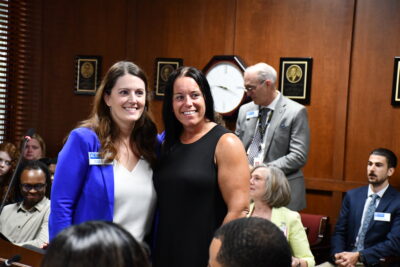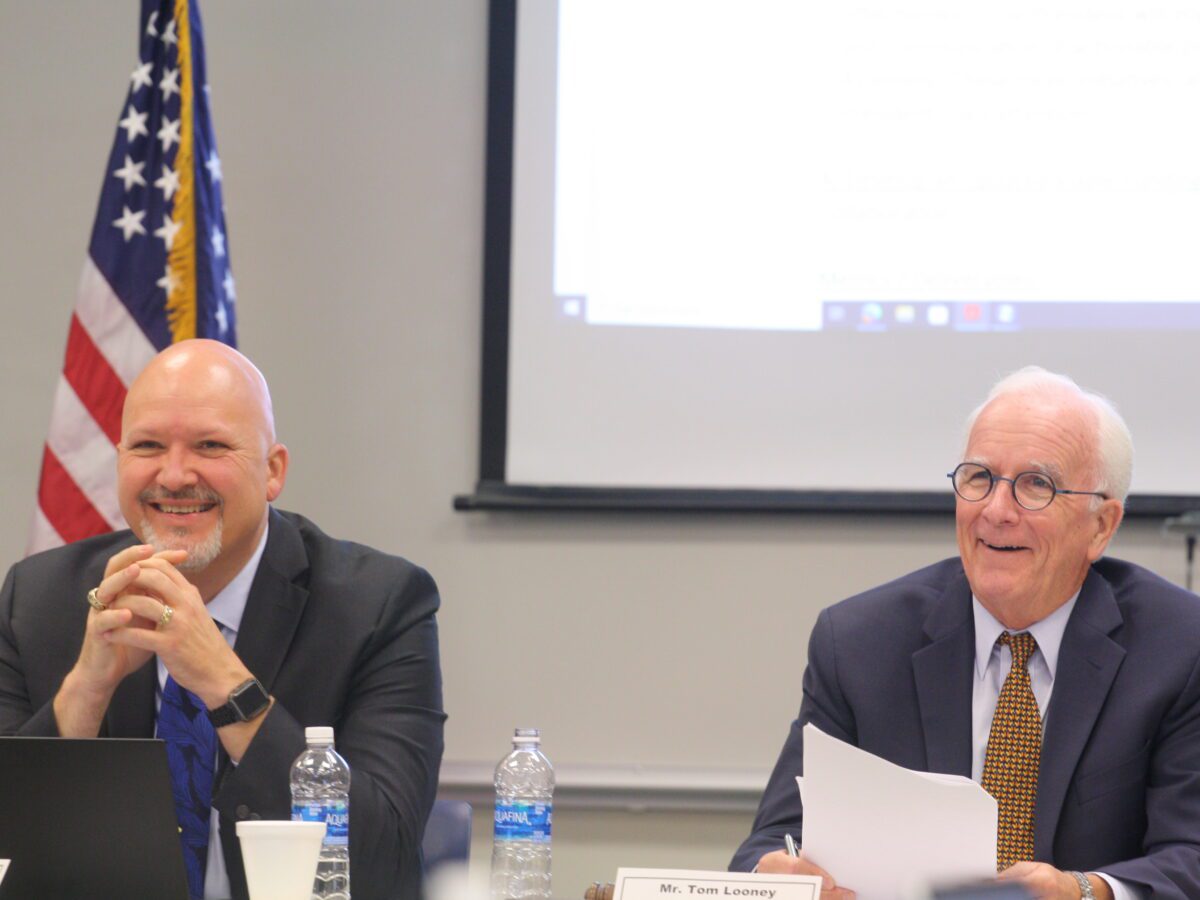

|
|
Last week, the State Board of Community Colleges approved its Year 1 goals for N.C. Community College System’s (NCCCS) President Dr. Jeff Cox, who started in the role on June 1.
Those goals include leading the system’s strategic plan initiatives, strengthening the system office’s structure and culture, engaging crucial constituencies, and facilitating development of a statewide marketing initiative.
“These goals are ambitious in nature, (and) will not all be accomplished within a year but are critical to our long-term success,” the goals document says. “We will measure the President by ascertaining how well he leads the System Office and Community Colleges in making progress toward these goals over the next year.”
The Board first identified a need to set goals for the system president in Dec. 2021 and Jan. 2022, when Thomas Stith was still president.
Next month, the Board is set to vote on another document outlining the evaluation process for these goals. Specifically, that document will outline what action items will result in a bonus for Cox.
“So much of what is in this document is already underway,” said Board member Ray Russell. “We are hoping to wrap up this process next month with that evaluation sheet.”
Below is a list of the goals approved last Friday. The full list of goals is available in the Board’s meeting materials.
- Lead strategic plan initiatives to advance the N.C. Community College System, including: developing an updated funding model, scaling system capacity for workforce development, and creating a sustainability plan for rural colleges.
- Strengthen system office structure, leadership development, and culture and engagement.
- Engage Crucial Constituencies, including the General Assembly, Governor, education and workforce partners, and more.
- Oversee the continued development and execution of a comprehensive, statewide and national communications, marketing, and branding plan.
This year’s goals were developed largely from the system’s four-year strategic plan, which was approved Oct. 2022. Last week, NCCCS Vice President of Strategic Initiatives Patrick Crane presented an update on tactics for the first year of the plan.
There are 10 tactics, including increasing faculty and staff salaries, strategic enrollment management, and expanding the N.C. Career Coach program.
Those tactics are meant for the Board to make sure the system is on the right track, Crane said.
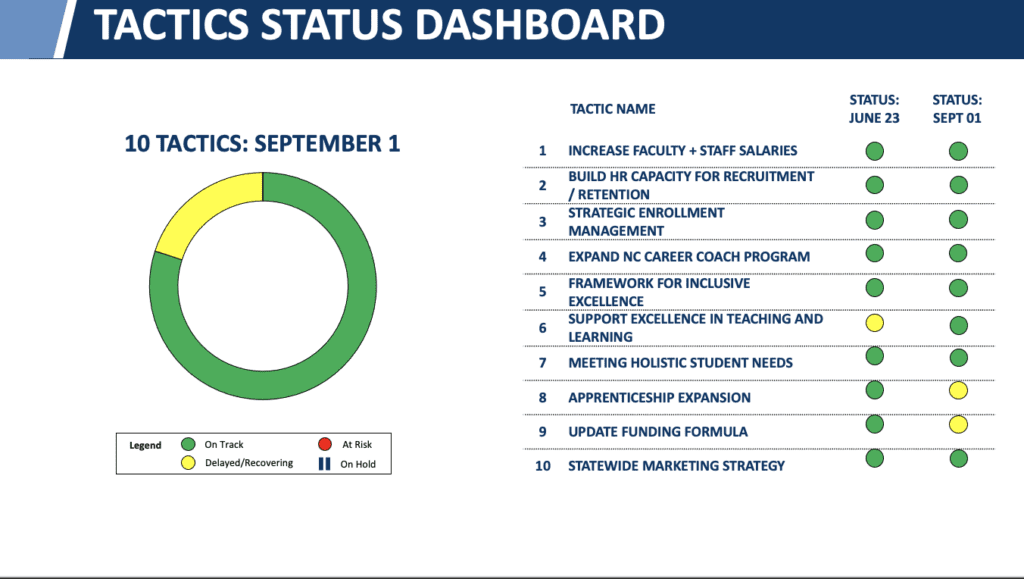

The resources needed to implement the tactics include additional funding, staffing, and stakeholder engagement, Crane said. Like other state agencies, the system is also waiting for a new budget to move forward in its future fiscal planning.
“We’re now moving from the strategic planning to execution,” Board Chair Tom Looney said. “So this really is a pivotal time.”
Ann Whitford, the chair of the strategic plan committee, echoed Looney. During the Board’s listening tour to develop the plan, Whitford said nearly every college mentioned an update to the system’s funding model. That item is part of the strategic plan and Cox’s goals for this year.
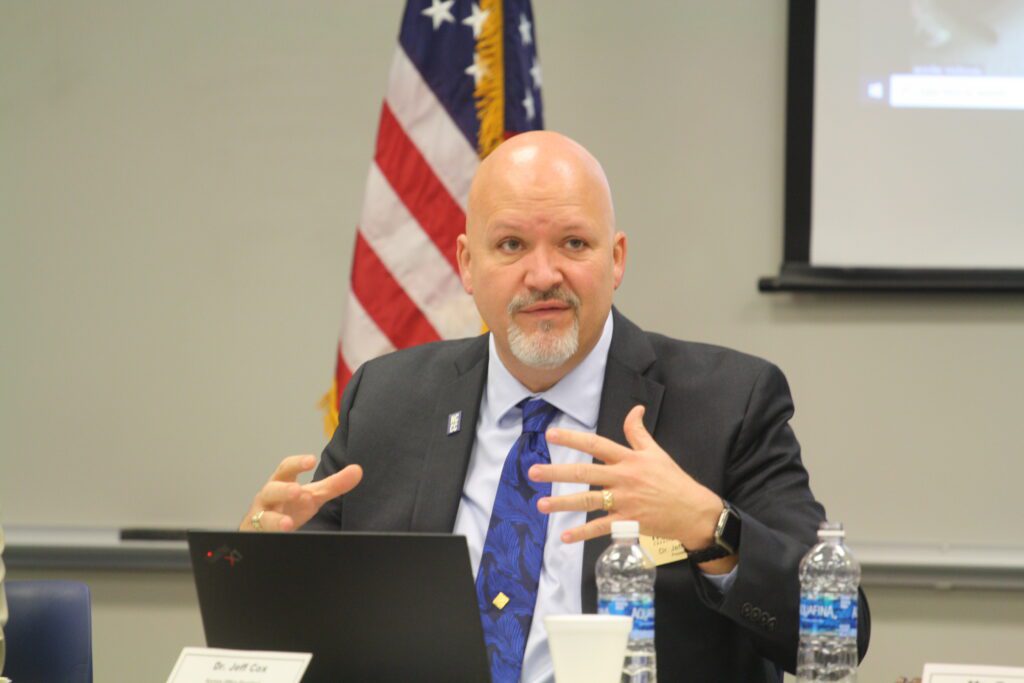

An update on a new funding formula
While community college funding in North Carolina is largely based on enrollment, the reality is very complex.
On Wednesday, Lenoir Community College President Dr. Rusty Hunt and NCCCS Chief Financial Officer Phillip Price presented an overview of the funding formula.
The majority of state funding falls into the instructional category and is distributed using a formula based on full-time equivalent (FTE) student enrollment. One FTE is equivalent to 512 hours of instruction.
The system has said it wants to update the current funding model, which is tied to FTE from previous years, to enable community colleges to be more innovative and proactive in their programs. This is particularly important when it comes to workforce development.
NCCCS stakeholders also have said they hope to see a funding formula that accounts more for the rise of part-time students at community colleges. Often, colleges offer more resources for part-time students but receive less FTE for them.
“We’re hoping to have something together to ask for the short session, instead of the long session,” Cox told the Board regarding the funding formula. “We will be giving monthly updates on that goal in particular.”
Approximately 78% of college operating funding came from the state last year, Price said, followed by 15% from county funds and 7% from institutional funds. Generally, state funding goes toward operating costs for instruction, administration, and support services. Local funds largely go toward the operation and maintenance of the campus and construction.
Below are some questions that came up during the Board’s discussion regarding the funding formula:
- The current FTE allotment is based on 16 credit hours. Should that allotment be lowered, as many community college students are not enrolled in four classes at a time?
- How should an updated formula better account for dual enrollment students?
- How might tier funding values be updated or reorganized?
- Do current base allocations need updating?
- Is it possible for the funding formula to help rural colleges with smaller budgets find funds for innovative workforce programs?
What other questions do you have about an updated funding formula? Let us know at hmcclellan@ednc.org.
Checking in on student programs
The Board also discussed and approved two annual legislative reports at the retreat — one on the comprehensive articulation agreement and another on outcomes from Career and College Ready Graduates.
The annual legislative report on the comprehensive articulation agreement, an agreement between the UNC System and NCCCS to streamline transfers between the two systems, “ensures that the agreement is fair, current, and relevant for all students and institutions.” The report, which was also approved by the UNC Board of Governors last week, is due by Nov. 1 to the Joint Legislative Education Oversight Committee.
The revised comprehensive articulation agreement (CAA) was signed in February 2014 and implemented the next fall.
“To date, the Transfer Advisory Committee (TAC) has completed three full rounds of
compliance visits to UNC System institutions,” the report says. “There have yet to be any reports of noncompliance by any institution.”
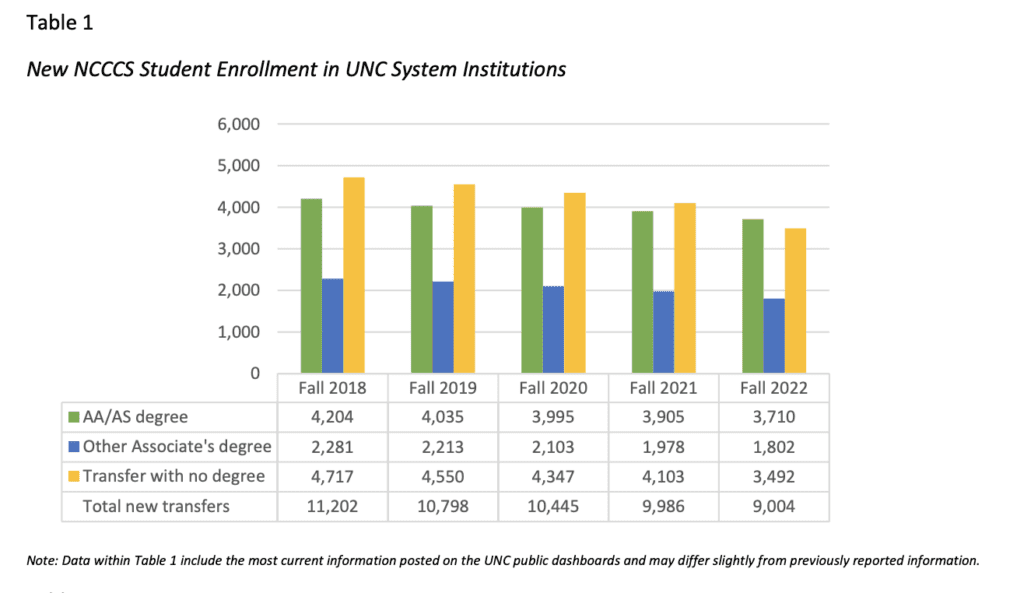

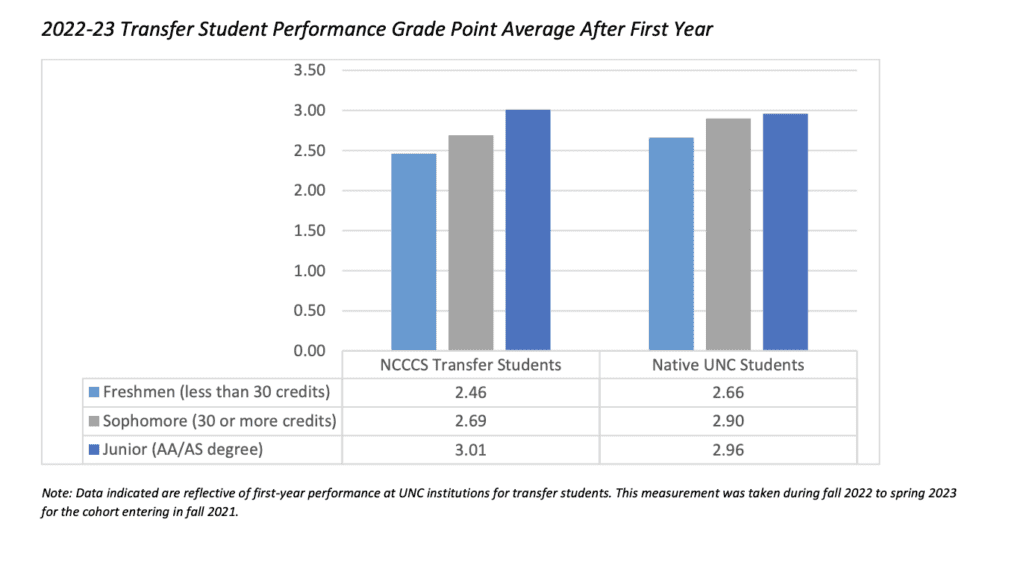

The report lists five recommendations from TAC:
- Technological and operational solutions that create greater continuity, clarity, accessibility, and transparency for advising and the processing of transfer students and informing course, program, and institution selection among the NCCCS and UNC System institutions, particularly through the implementation of statewide data sharing between the two systems.
- A more unified approach to transfer, where the TAC not only provides input on issues related to the CAA but also any on others related to the successful transfer between the public and private two- and four-year institutions in the state.
- A website and/or mobile application that allows students to see how credit earned at one
institution would be counted at another – a true degree audit for transfer credit; - Additional training for community college and university employees on the benefits and
guarantees of the CAA. - Continuing collaborations with other key partners (e.g., the Belk Center for Community College Leadership and Research, myFutureNC, North Carolina Independent Colleges and Universities, etc.) in the work of transfer success.
“In the past nine years, NCCCS and UNC System institutions have made steady progress toward seamless transfer,” the report says. “They continue to perfect and improve their partnerships to provide more effective advising, clear and consistent communication, and ongoing support to transfer students.”
The Board also approved its annual report to the General Assembly on the Career and College-Ready Graduate (CCRG) Program. That report was approved by the State Board of Education earlier this month.
The CCRG program is the state’s attempt to address the long-standing challenges of supporting students who enroll in community colleges unprepared in English or math. The program was established as a pilot in 2016 as a partnership between the public school and community college systems to offer remediation to high school seniors.
The General Assembly funded the program for the first time in 2022, which marked the start of the first full year of implementation.
More than 600 student respondents completed the survey associated with the report, and a majority of them said they were able to work at their own pace and take their time on the content. However, only about 25% felt that CCRG helped them learn new content or save money in college.
To improve the program, students advocated for fewer multi-step questions, shorter diagnostic tests, accessibility improvements in the course platform, and simplifying both instruction and testing.
To pass, students must take the Tier Tests for math and English and score an 80 or higher. According to the report, English 1 only had a 10% pass rate, and English 2 had a 7% pass rate. In comparison, Math 1 had a 86% pass rate, Math 2 had a 83% pass rate, and Math 3 had a 86% pass rate.
The report recommended reassessing the English curriculum implementation “to allow for flexibility like that of the CCRG math implementation.”
“Enrollment data of these graduates into the community colleges is not yet available,” the report says. “The NCCCS anticipates that data will be available in the coming year once full implementation of CCRG is delivered across the state.”
Other meeting business
- Jeff DeBellis, director of economic and policy analysis at the NC Department of Commerce, presented a labor market forecast, “North Carolina’s Economic Recovery & Future.” The presentation also included an overview of the department’s dashboard on workforce data.
- The Board approved the expenditure of up to $300,000 for website redesign funds for the system. That amount was updated to account for “for post implementation support and hosting services.”
- The Board approved its Annual Audit Plan, which was originally scheduled to be approved next month. The top two auditable risks are cybersecurity and human resources performance management.
- Board members also heard a cybersecurity update. The Board was briefed on a June 29 data breach at National Student Clearinghouse, associated with their third party solution MOVEit Transfer, which impacted 57 of the state’s community colleges. The average number of reportable records exposed by the breach per college “appeared small,” the cybersecurity update says.
- The Board approved a number of promotions within the system office, pending funding from the new budget. One of those promotions was for Dr. Bill Schneider, who is currently the associate vice president of research and performance management. Pending funding, he will join the senior team to lead data efforts at the system as vice president of system effectiveness.
- Finally, the Board approved “significant reorganization” of system positions to support Enterprise Resource Planning (ERP) modernization. Those changes impact 12 positions, many of which will work with Schneider’s new team.
The next State Board meeting is scheduled for Oct. 19-20 at the System Office in Raleigh.



